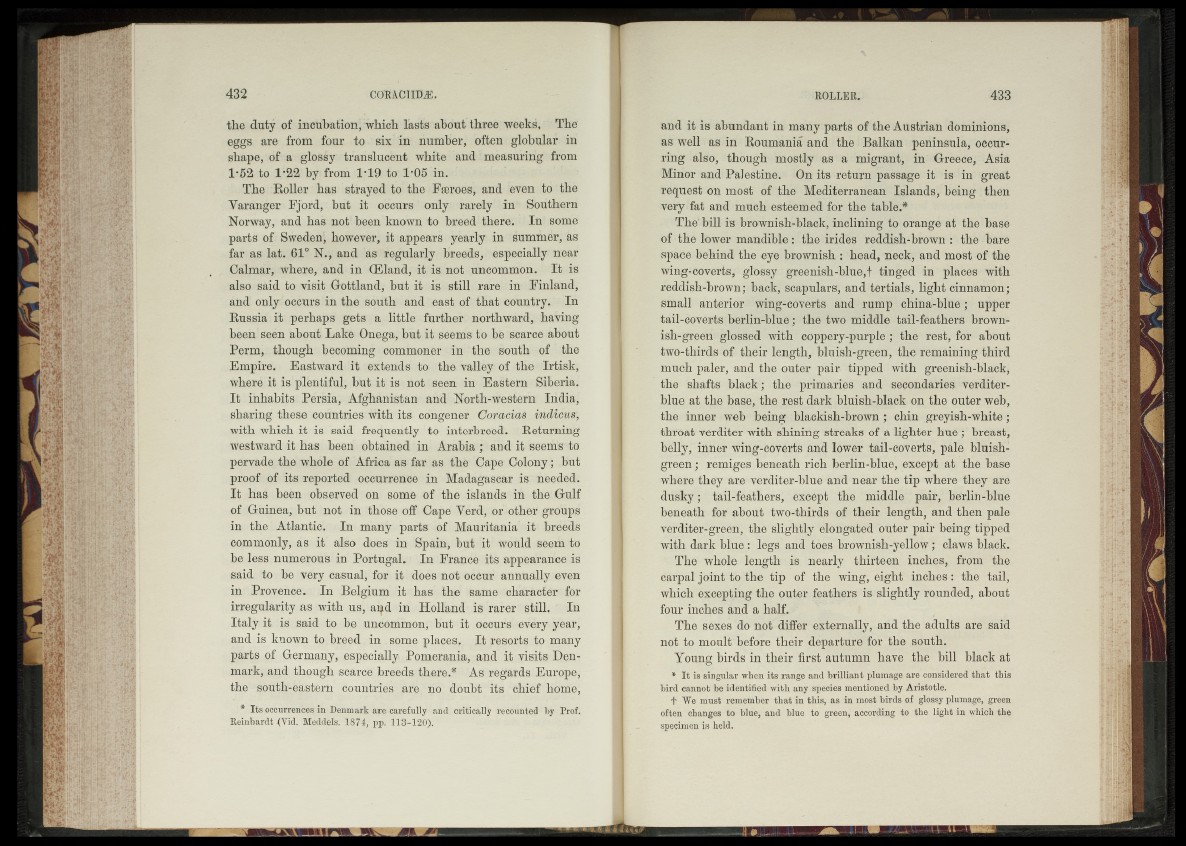
the duty of incubation, which lasts about three weeks, The
eggs are from four to six in number, often globular in
shape, of a glossy translucent white and measuring from
1*52 to 1*22 by from 1*19 to 1*05 in.
The Roller has strayed to the Faeroes, and even to the
Yaranger Fjord, but it occurs only rarely in Southern
Norway, and has not been known to breed there. In some
parts of Sweden, however, it appears yearly in summer, as
far as lat. 61° N., and as regularly breeds, especially near
Calmar, where, and in (Eland, it is not uncommon. It is
also said to visit Gottland, but it is still rare in Finland,
and only occurs in the south and east of that country. In
Russia it perhaps gets a little further northward, having
been seen about Lake Onega, but it seems to be scarce about
Perm, though becoming commoner in the south of the
Empire. Eastward it extends to the valley of the Irtisk,
where it is plentiful, but it is not seen in Eastern Siberia.
It inhabits Persia, Afghanistan and North-western India,
sharing these countries with its congener Coracias indicus',
with which it is said frequently to interbreed. Returning
westward it has been obtained in Arabia; and it seems to
pervade the whole of Africa as far as the Cape Colony; but
proof of its reported occurrence in Madagascar is needed.
It has been observed on some of the islands in the Gulf
of Guinea, but not in those off Cape Yerd, or other groups
in the Atlantic. In many parts of Mauritania it breeds
commonly, as it also does in Spain, but it would seem to
be less numerous in Portugal. In France its appearance is
said to be very casual, for it does not occur annually even
in Provence. In Belgium it has the same character for
irregularity as with us, and in Holland is rarer still. In
Italy it is said to be uncommon, but it occurs every year,
and is known to breed in some places. It resorts to many
parts of Germany, especially Pomerania, and it visits Denmark,
and though scarce breeds there.* As regards Europe,
the south-eastern countries are no doubt its chief home,
* Its occurrences in Denmark are carefully and critically recounted by Prof.
Beinhardt ifVid. Meddels. 1874, pp. 113-120).
and it is abundant in many parts of the Austrian dominions,
as well as in Roumania and the Balkan peninsula, occurring
also, though mostly as a migrant, in Greece, Asia
Minor and Palestine. On its return passage it is in great
request on most of the Mediterranean Islands, being then
very fat and much esteemed for the table.*
The' bill is brownish-black, inclining to orange at the base
of the lower mandible: the irides reddish-brown : the bare
space behind the eye brownish : head, neck, and most of the
wing-coverts, glossy greenish-blue,! tinged in places with
reddish-brown; back, scapulars, and tertials, light cinnamon;
small anterior wing-coverts and rump china-blue; upper
tail-coverts berlin-blue; the two middle tail-feathers brownish
green glossed with coppery-purple; the rest, for about
two-thirds of their length, bluish-green, the remaining third
much paler, and the outer pair tipped with greenish-black,
the shafts black; the primaries and secondaries verditer-
blue at the base, the rest dark bluish-black on the outer web,
the inner web being blackish-brown ; chin greyish-white ;
throat verditer with shining streaks of a lighter hu e; breast,
belly, inner wing-coverts and lower tail-coverts, pale bluish-
green ; remiges beneath rich berlin-blue, except at the base
where they are verditer-blue and near the tip where they are
dusky; tail-feathers, except the middle pair, berlin-blue
beneath for about two-thirds of their length, and then pale
verditer-green, the slightly elongated outer pair being tipped
with dark blue : legs and toes brownish-yellow; claws black.
The whole length is nearly thirteen inches, from the
carpal joint to the tip of the wing, eight inches: the tail,
which excepting the outer feathers is slightly rounded, about
four inches and a half.
The sexes do not differ externally, and the adults are said
not to moult before their departure for the south.
Young birds in their first autumn have the bill black at
* I t is singular when its range and brilliant plumage are considered that this
bird cannot be identified with any species mentioned by Aristotle.
+ We must remember that in this, as in most birds of glossy plumage, green
often changes to blue, and blue to green, according to the light in which the
specimen is held.